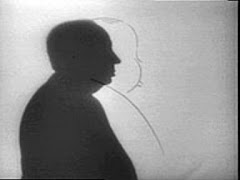I spent some of my happiest hours in some of my most formative years working in a photocopy and print shop, at the same time as pondering questions of originality and copying as part of PhD research into notions of authorship. So, for me, a truly must-see film was Austrian filmmaker Virgil Widrich 's dizzyingly virtuosic Copy Shop (2001). This film 'consists of nearly 18,000 photocopied digital frames, which are animated and filmed with a 35mm camera' (see the 'Making of Copy Shop' HERE). Its full-length version is quite widely available as part of the Cinema 16: European Short Films (2006) DVD.
Below is the little essay about Copy Shop reproduced on its website. Along with the video interview with Widrich embedded beneath it, it's an interesting example of what I call (following Timothy Corrigan's conceptualisation of the extra-textual notion of cinematic authorship - 'the commerce of auteurism') 'Directing Cinema' discourse, the phenomenon by which the director (or the 'ghost director' - i.e. a film marketing department) attempts to 'direct' (us) before, during, and (as here) after the film's production.
Identity and the cinema
Cinema enables the viewer to adopt an "alter-ago" for a while, safe in the knowledge that, no matter what happens, the film will be over at some point. This alter-ego can "slip into" one or more of the characters on the screen. In movies, identification is usually achieved by using "subjective shots" so that the viewer sees what the character "sees", thus merging with the character. A sequence of this kind usually looks like this:
A) Objective shot: The character looks past the cameraB) Subjective shot: The camera shows what the character sees
C) Objective shot: The character reacts to what he/she has seen
"Copy Shop" takes this a step further: the viewer is identified with a character, who then proceeds to lose his own identity.
1. Objective = Subjective
In the cinema, one important rule must be adhered to so that the viewer registers the change from an objective to a subjective angle, at least subconsciously: the difference between objective and subjective angles is that the one watching must never be directly visible in a subjective shot. In "Copy Shop" this rule is deliberately broken. The same shot is used first as an objective angle, and again later as a subjective angle, i.e. the same perspective can be perceived by different observers. For example: At the beginning of the story "we" (objective shot) see Alfred Kager wake up and go into the bathroom.In a later scene "we" (objective shot) see Alfred Kager standing in the bathroom looking into the bedroom. "We" see what Alfred Kager "sees", and for this exactly the same shot is used as was used at the beginning: a doppelgänger, who looks like Alfred Kager, is lying in bed (subjective shot), wakes up and goes into the bathroom.
In a still later scene, when there are already three Alfred Kagers, the objective view of Kager standing in the bathroom and looking, which has already been seen, becomes the subjective view of Kager observing a doppelgänger standing in the bathroom, who is in turn watching, in a kind of subordinate subjective shot, as a further doppelgänger lies in bed, wakes up and goes into the bathroom. The first two thirds of the film give the viewer time to come to grips with the game. As long as the viewer knows who is "who", it is also perfectly clear to him/her which of the identical characters is the real Alfred Kager. It is not until the final third that the film gathers speed to such a degree that the identifications become confused.
2. The frame as a copy of the original
"Copy Shop" shows a protagonist fighting for his originality as an individual. But in "Copy Shop" not even the frames are originals; they are only copies. This is done not only to express the fact that the cinema copy is the usual kind of copy for movie theatres, but also that the frames are really and truly "copies" in the literal sense of the word. The technical realization of "Copy Shop" involved the transfer of every single frame from the digital video tape into the computer once the shooting had been finished, from where the frames were printed out on a black and white laser printer and then filmed again with a 35mm animation camera. Thus video becomes paper, paper becomes film and the story of "Copy Shop" is brought to life again "copy by copy".3. Cinema as a copier
"Copy Shop" is about a copy centre, in other words about the duplication of single pictures which are whisked through machines (in this case copiers) at ever increasing speed. The speed of this duplication, which rises to 24 frames a second in the course of the story, represents an acoustic and optical correlation to the related process of a film projector’s operation. Kager, the hero of "Copy Shop", fights not only against his doppelgängers, but above all against the pictures that they copy and thus against the film in which he is forever entrapped.
Thanks a lot to Joanna Kerr for telling me about this film. And thanks to Virgil Widrich, its brilliant director.
Incidentally, the new Cinema 16 - World Short Films (2008) has just been released.






No comments:
Post a Comment